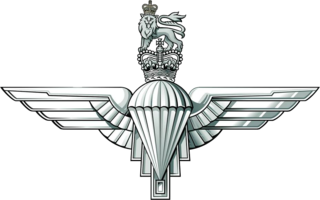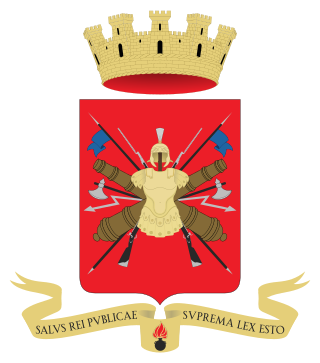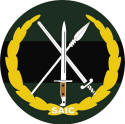
A paratrooper is a military parachutist—someone trained to parachute into a military operation, and usually functioning as part of an airborne force. Military parachutists (troops) and parachutes were first used on a large scale during World War II for troop distribution and transportation. Paratroopers are often used in surprise attacks, to seize strategic objectives such as airfields or bridges.

A battalion is a military unit, typically consisting of 300 to 1,000 soldiers commanded by a lieutenant colonel, and subdivided into a number of companies. The typical battalion is built from three operational companies, one weapons company and one HQ company. In some countries, battalions are exclusively infantry, while in others battalions are unit-level organisations.

The Parachute Regiment, colloquially known as the Paras, is an airborne infantry regiment of the British Army. The first battalion is part of the Special Forces Support Group under the operational command of the Director Special Forces. The other battalions are the parachute infantry component of the British Army's rapid response formation, 16 Air Assault Brigade. The Paras, along with the Guards, are the only line infantry regiment of the British Army that has not been amalgamated with another unit since the end of the Second World War.

The Italian Army is the land-based component of the Italian Armed Forces. The army's history dates back to the Italian unification in the 1850s and 1860s. The army fought in colonial engagements in China, Libya, Northern Italy against the Austro-Hungarian Empire during World War I, Abyssinia before World War II and in World War II in Albania, Balkans, North Africa, the Soviet Union, and Italy itself. During the Cold War, the army prepared itself to defend against a Warsaw Pact invasion from the east. Since the end of the Cold War, the army has seen extensive peacekeeping service and combat in Afghanistan and Iraq. Its best-known combat vehicles are the Dardo infantry fighting vehicle, the Centauro tank destroyer and the Ariete tank and among its aircraft the Mangusta attack helicopter, recently deployed in UN missions. The headquarters of the Army General Staff are located in Rome opposite the Quirinal Palace, where the president of Italy resides. The army is an all-volunteer force of active-duty personnel.

The South African Army Infantry Formation supervises all infantry within the South African Army.
Operation Prone was a proposed military operation by the South African Defence Force (SADF) and South West African Territorial Force (SWATF) during the South African Border War and Angolan Civil War between May and September 1988. With the advance of the 50th Cuban Division towards Calueque and the South-West Africa border, the SADF formed the 10 SA Division to counter this threat. The plan for Operation Prone had two phases. Operation Linger was to be a counterinsurgency phase and Operation Pact a conventional phase.

The 1st Airlanding Brigade was an airborne infantry brigade of the British Army during the Second World War and the only glider infantry formation assigned to the 1st Airborne Division, serving alongside the 1st Parachute Brigade and 4th Parachute Brigade.

The 4th Battalion, Parachute Regiment, is an Army Reserve unit of the British Army. Now recruiting across the United Kingdom originally the Battalion covered the North of England, with its headquarters located in Pudsey, West Yorkshire. Following the Options for Change review in 1993, 4 PARA amalgamated with the 15th (Scottish) Battalion of the Parachute Regiment, which was downsized and became 15 (Scottish) Company of 4 PARA. As part of further changes in 1999, the Battalion also merged with the 10th (Volunteer) Battalion which then became 10 (London) Company.

44 Parachute Brigade was a parachute infantry brigade of the South African Army. It was founded on 20 April 1978, by Colonel Jan Breytenbach, following the disbandment of 1 SA Corps and the battle of Cassinga. Upon formation, the brigade was commanded by Brigadier M. J. du Plessis, who was assigned the task of establishing by working with the Parachute Staff Officer, Colonel Jan Breytenbach. At the time du Plessis was the commanding officer of the Orange Free State Command and had previous experience serving in 1 Parachute Battalion. Breytenbach had also been a member of 1 Parachute Battalion and had also founded the South African Special Forces Brigade and 32 Battalion. The location that was chosen for the brigade's headquarters was in the lines of the OFS Cmd Headquarters, next to the old Tempe Airfield in Bloemfontein.

The 7th Parachute Battalion was an airborne infantry battalion of the Parachute Regiment, formed by the British Army during the Second World War. The battalion was raised in November 1942 by the conversion of the 10th Battalion, Somerset Light Infantry to parachute duties. It was initially assigned to the 3rd Parachute Brigade, part of 1st Airborne Division, but moved to the 5th Parachute Brigade, alongside the 12th and 13th Parachute battalions, of the 6th Airborne Division soon afterwards.

The 11th Parachute Battalion was an airborne infantry battalion of the Parachute Regiment, raised by the British Army in World War II.

The 8th (Midlands) Parachute Battalion was an airborne infantry battalion of the Parachute Regiment, raised by the British Army during the Second World War. The battalion was created in late 1942 by the conversion of the 13th Battalion, Royal Warwickshire Regiment to parachute duties. The battalion was assigned to the 3rd Parachute Brigade, serving alongside the 7th and 9th Parachute battalions, in the 1st Airborne Division before being reassigned to help form the 6th Airborne Division in May 1943.

The 13th (Lancashire) Parachute Battalion was an airborne infantry battalion of the Parachute Regiment, raised by the British Army during the Second World War. The battalion was formed in May 1943 by the conversion of the 2/4th Battalion, South Lancashire Regiment to parachute duties and was assigned to the 5th Parachute Brigade in the 6th Airborne Division.
The Northern Army Group (NORTHAG) was a NATO military formation comprising five Army Corps from five NATO member nations. During the Cold War NORTHAG was NATO's forward defence in the Northern half of the Federal Republic of Germany (FRG). The Southern half of the Federal Republic of Germany was to be defended by the four Army Corps of NATO's Central Army Group (CENTAG). During wartime NORTHAG would command four frontline corps and one reserve corps. Air support was provided by Second Allied Tactical Air Force.

The Portuguese Paratroopers are an elite infantry assault force, representing the bulk of the airborne forces of Portugal. They were created in 1956 as part of the Portuguese Air Force, being transferred to the Portuguese Army in 1993. Presently, most of the Paratroopers are part of the Portuguese Rapid Reaction Brigade which comprises all 3 special forces troops.

Armoured Troops are the corps in the Ukrainian Ground Forces, the main striking force of ground troops. They are used primarily in conjunction with mechanized forces in key areas and perform the following tasks:

The 2nd Carabinieri Mobile Brigade, based in Livorno, is the Carabinieri formation dedicated to military missions abroad, including military police tasks. It employs the 7th Carabinieri Regiment "Trentino-Alto Adige", the 13th Carabinieri Regiment "Friuli-Venezia Giulia", the 1st Parachute Carabinieri Regiment "Tuscania" and the Gruppo di intervento speciale.
The following is a hierarchical outline for the structure of the British Army in 1989. The most authoritative source for this type of information available is Ministry of Defence, Master Order of Battle, and United Kingdom Land Forces, HQ UKLF, UKLF ORBAT Review Action Plan, HQ UKLF, 1990.

The 3rd (Volunteer) Battalion, Cheshire Regiment was a part-time infantry battalion based in Cheshire, England and tasked with home defence during its tenure. The battalion was formed in the latter part of the Cold War, but later disbanded forming two companies in the new local Territorial Army (TA) regiment, the King's and Cheshire Regiment. Today, the battalion's lineage is continued in Mortar Platoon, B Company, 4th Battalion, Mercian Regiment.











